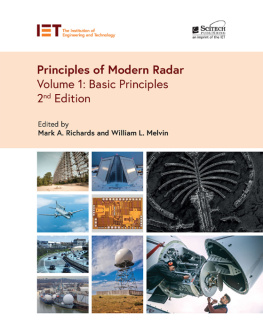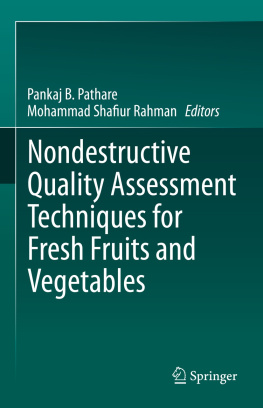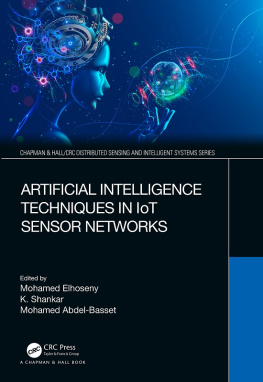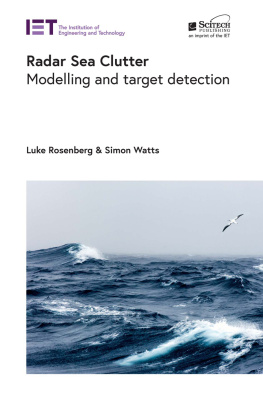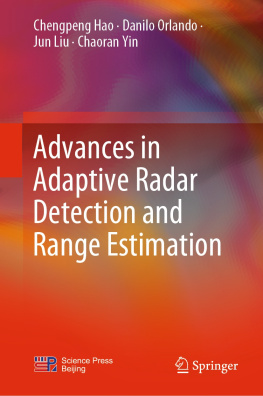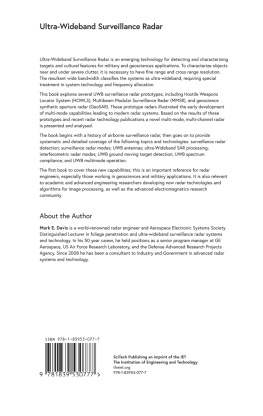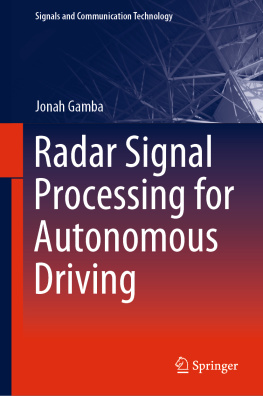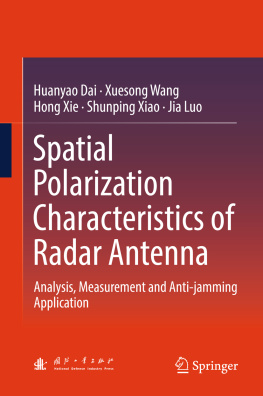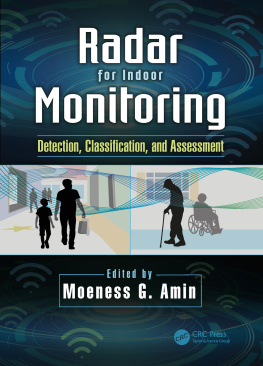ADVANCED
ULTRAWIDEBAND
RADAR
SIGNALS, TARGETS, AND APPLICATIONS
ADVANCED
ULTRAWIDEBAND
RADAR
SIGNALS, TARGETS, AND APPLICATIONS
EDITED BY
JAMES D. TAYLOR

Cover Photo
Ultrawideband radar systems can operate a distances from direct contact to orbital ranges.
Left: Photograph of UWB radar measuring animal activity in biological experiments from . (Photo by Lesya Anishchenko, Bauman Remote Sensing Laboratory, Bauman Moscow State Technical University.)
Center: show how UWB radar can inspect installed materials such as space vehicle cryogenic tank coatings and aircraft composite structural components. (NASA Photo)
Right: The MIT Lincoln Laboratory Haystack Ultrawideband Satellite Imaging Radar (HUSIR) can image satellites in space. See . (Permission of MIT LL)
CRC Press
Taylor & Francis Group
6000 Broken Sound Parkway NW, Suite 300
Boca Raton, FL 33487-2742
2017 by Taylor & Francis Group, LLC
CRC Press is an imprint of Taylor & Francis Group, an Informa business
No claim to original U.S. Government works
Printed on acid-free paper
Version Date: 20160913
International Standard Book Number-13: 978-1-4665-8657-4 (Hardback)
This book contains information obtained from authentic and highly regarded sources. Reasonable efforts have been made to publish reliable data and information, but the author and publisher cannot assume responsibility for the validity of all materials or the consequences of their use. The authors and publishers have attempted to trace the copyright holders of all material reproduced in this publication and apologize to copyright holders if permission to publish in this form has not been obtained. If any copyright material has not been acknowledged please write and let us know so we may rectify in any future reprint.
Except as permitted under U.S. Copyright Law, no part of this book may be reprinted, reproduced, transmitted, or utilized in any form by any electronic, mechanical, or other means, now known or hereafter invented, including photocopying, microfilming, and recording, or in any information storage or retrieval system, without written permission from the publishers.
For permission to photocopy or use material electronically from this work, please access (http://www.copyright.com/) or contact the Copyright Clearance Center, Inc. (CCC), 222 Rosewood Drive, Danvers, MA 01923, 978-750-8400. CCC is a not-for-profit organization that provides licenses and registration for a variety of users. For organizations that have been granted a photocopy license by the CCC, a separate system of payment has been arranged.
Trademark Notice: Product or corporate names may be trademarks or registered trademarks, and are used only for identification and explanation without intent to infringe.
Library of Congress Cataloging-in-Publication Data
Names: Taylor, James D., 1941- editor.
Title: Advanced ultrawideband radar : signals, targets, and applications / edited by James D. Taylor.
Description: Boca Raton, FL : CRC Press, Taylor & Francis Group, 2016.
Identifiers: LCCN 2016028361| ISBN 9781466586574 (hardback) | ISBN 9781466586604 (ebook)
Subjects: LCSH: Ultra-wideband radar.
Classification: LCC TK6592.U48 A38 2016 | DDC 621.3848/5--dc23
LC record available at https://lccn.loc.gov/2016028361
Visit the Taylor & Francis Web site at
http://www.taylorandfrancis.com
and the CRC Press Web site at
http://www.crcpress.com
Contents
James D. Taylor
Gennadiy P. Pochanin, Sergey A. Masalov, Vadym P. Ruban, Pavlo V. Kholod, Dmitriy O. Batrakov, Angelika G. Batrakova, Liudmyla A. Varianytsia-Roshchupkina, Sergey N. Urdzik, and Oleksandr G. Pochanin
James D. Taylor, Anatoliy Boryssenko, and Elen Boryssenko
Terence W. Barrett
Oleg I. Sukharevsky, Gennady S. Zalevsky, and Vitaly A. Vasilets
Edison Cristofani, Fabian Friederich, Marijke Vandewal, and Joachim Jonuscheit
Lanbo Liu
Lesya Anishchenko, Timothy Bechtel, Sergey Ivashov, Maksim Alekhin, Alexander Tataraidze, and Igor Vasiliev
Ram M. Narayanan
Lorenzo Capineri, Timothy Bechtel, Pierluigi Falorni, Masaharu Inagaki, Sergey Ivashov, and Colin Windsor
Fauzia Ahmad, Traian Dogaru, and Moeness Amin
Franois Le Chevalier
In late 1990, I had lunch with Dr. Michael Salour, the president of IPITEC Corp, a fiber optics company. When I described ultrawideband radar, he asked Are there any books about it? I replied, No, its too new of a subject. Michael thought for a minute and said, Why dont you write one? Michaels suggestion evolved into the series that started in 1995 with Introduction to Ultra-Wideband Radar Technology, followed by Ultra-Wideband Radar Technology (2000) and Ultrawideband Radar Technology Applications and Design in 2012.
Every time I finish writing and editing a new book, I think it will be the last one. Then I see the progress reported and start another. My special thanks to all of the writers who contributed chapters about their special research areas. Their gracious cooperation and positive responses to my editing and suggested changes greatly eased this otherwise daunting enterprise.
Advanced Ultrawideband Radar: Signals, Targets, and Applications presents the latest progress in ultrawideband (UWB) radar technology and shows new directions for future development and applications. I have edited for the practical engineer or technical manager who wants to learn about what UWB radar can do for them. The writers have shown the applications, technical issues, and solutions supported by the background theory.
For practical purposes, UWB now means all radar systems with a small spatial resolution, generally less than 30 cm (1 ft) or a signal bandwidth greater than 500 MHz. The practical uses of high resolution signals have evolved to provide greater remote sensing capabilities. Advances in integrated circuits and signal processing technology have enabled applications from short-range buried object detection to imaging satellites at geosynchronous orbit altitudes. Crime drama and history channel television enthusiasts often see detectives or archeologists using ground penetrating radar to search for evidence at crime scenes or historical sites. Future air travelers may unknowingly pass through a UWB imaging radar that searches their bodies for weapons or contraband. Highway departments use UWB radars to inspect road beds and bridges.
For the future, imagine a medical radar scanner for use in the field at primitive medical facilities such as a remote clinic or battlefield hospital. The advanced UWB radar technology presented here can expand remote sensing by adding timefrequency analysis of return signals (spectroscopy) for target identification, range measurement, and imaging.
The following chapters will show how a radar could analyze the spectrum of reflected signals. Comparing timefrequency profiles against a data base can provide a way to identify objects. Carried a step further, the radar can then change the transmitted signal spectrum to match the target for an enhanced response using correlation processing. This will open major possibilities for medical applications including internal imaging.
Next page

